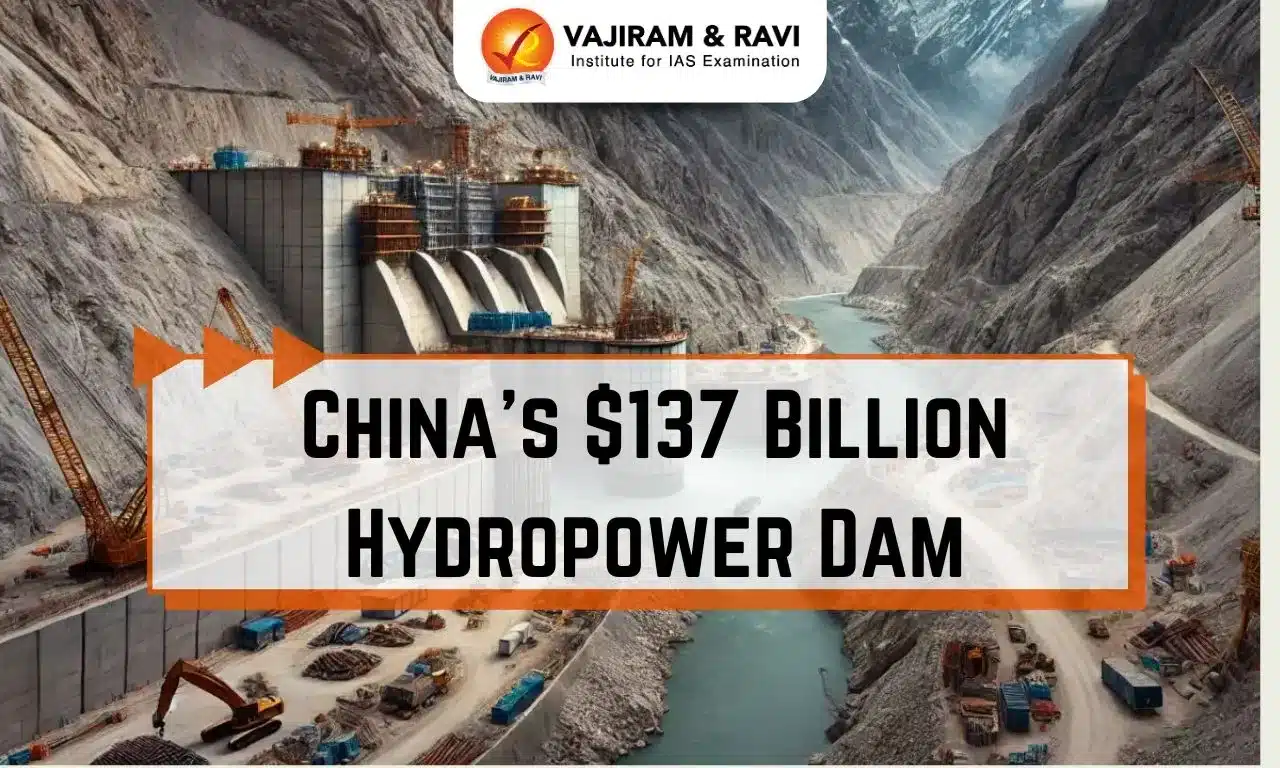What’s in today’s article?
- Why in News?
- Course of the river Brahmaputra
- China’s Brahmaputra Dam project
- Concerns and implications of China’s Tibet dam project on India
- India’s response
Why in News?
China has approved the construction of the world’s largest hydropower dam on the lower reaches of the Yarlung Zangbo River (Brahmaputra) on the Tibetan plateau.
The ambitious project aims to produce 300 billion kilowatt-hours (kWh) of electricity annually, more than tripling the capacity of the Three Gorges Dam, the current world leader in hydropower.
Course of the river Brahmaputra
- The Brahmaputra, originating in Tibet as the Yarlung Tsangpo, flows through India’s Arunachal Pradesh and Assam before entering Bangladesh and emptying into the Bay of Bengal.
- As a perennial river, it sustains communities through irrigation, fisheries, and inland transport.
- While it enriches agriculture by depositing fertile alluvial soil, its lower course poses challenges with recurring, devastating floods in Assam and Bangladesh due to climatic and geographical conditions.
China’s Brahmaputra Dam project

- About
- China is constructing the dam in Medog County, Tibet Autonomous Region, where the Yarlung Tsangpo drops 2,000 meters, creating ideal hydropower conditions.
- The project is part of China’s renewable energy initiatives, aiming to achieve carbon neutrality by 2060 while promoting regional development in Tibet.
- The project, costing $137 billion, is part of China’s 14th Five-Year Plan (2021–2025) and Long-Range Objectives through 2035.
- Scale and Significance of the Project
- The dam is projected to generate up to 60 gigawatts of power, triple the capacity of the Three Gorges Dam.
- It will produce 300 billion kWh of clean, renewable electricity annually, supporting Beijing’s clean energy targets and bolstering water security.
- The project will generate 20 billion yuan ($3 billion) annually for Tibet.
Concerns and implications of China’s Tibet dam project on India
- Agriculture
- The dam could retain a significant amount of silt, which is crucial for downstream agriculture. Reduced silt deposits may negatively impact the fertility of agricultural lands in India.
- Water Resources
- China claims the dam is a run-of-the-river hydropower project.
- However, experts warn it could reduce water flow downstream during dry seasons and exacerbate flooding during monsoons if excess water is released, potentially causing disasters in Assam.
- Potential Use of Water as a Weapon
- China’s upstream position gives it control over the Brahmaputra’s flow.
- During geopolitical tensions, such as the 2017 Doklam standoff, China withheld hydrological data crucial for flood forecasting, raising concerns over the weaponization of water resources.
- Seismological Threats
- The Himalayan region’s seismic vulnerability could pose risks to downstream populations due to the scale of infrastructure projects like this dam.
- Ecological Impact
- The dam could disrupt the fragile Himalayan ecosystem, home to critically endangered species.
- Combined with ongoing climate change effects, deforestation, and soil erosion, the ecological consequences may be severe.
India’s Response
- India has urged China to safeguard downstream interests.
- Additionally, India is planning a 10 GW hydropower project in the Dibang Valley, Arunachal Pradesh, to counterbalance the potential impacts of China’s dam.
- Also, data sharing between India and China on trans-border rivers, established under the Expert Level Mechanism (ELM) in 2006, remains critical.
Q.1. What is the significance of China’s Brahmaputra Dam project?
China’s Brahmaputra Dam aims to produce 300 billion kWh of renewable energy annually, supporting its carbon neutrality goal and generating $3 billion annually for Tibet. It also represents China’s focus on large-scale renewable energy infrastructure.
Q.2. How could China’s dam project impact India?
The dam may reduce downstream water flow, disrupt agriculture by retaining fertile silt, and amplify floods during monsoons. Additionally, its upstream position gives China leverage in controlling water resources during geopolitical tensions.
Last updated on June, 2025
→ UPSC Notification 2025 was released on 22nd January 2025.
→ UPSC Prelims Result 2025 is out now for the CSE held on 25 May 2025.
→ UPSC Prelims Question Paper 2025 and Unofficial Prelims Answer Key 2025 are available now.
→ UPSC Calendar 2026 is released on 15th May, 2025.
→ The UPSC Vacancy 2025 were released 1129, out of which 979 were for UPSC CSE and remaining 150 are for UPSC IFoS.
→ UPSC Mains 2025 will be conducted on 22nd August 2025.
→ UPSC Prelims 2026 will be conducted on 24th May, 2026 & UPSC Mains 2026 will be conducted on 21st August 2026.
→ The UPSC Selection Process is of 3 stages-Prelims, Mains and Interview.
→ UPSC Result 2024 is released with latest UPSC Marksheet 2024. Check Now!
→ UPSC Toppers List 2024 is released now. Shakti Dubey is UPSC AIR 1 2024 Topper.
→ Also check Best IAS Coaching in Delhi






















